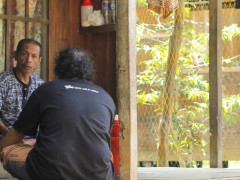Recurring Forest and Land Fires, a Bad Reflection on the Peat Protection Effort
By Hairul Sobri3 Reasons Why Food Estate is Not the Answer for the Food Security and Nutrition Agenda
The topic of food security has once again attracted public attention, this time in its relation to the COVID-19 pandemic. The cause is mainly about the problem of food insecurity because of the disruptions in domestic food supply chain and food production processes, as a result of social distancing during pandemic and lay-off of many workers. The increasing unemployment rate can potentially reduce purchasing power and increase food and nutrition insecurity. The Food and Agriculture Organization (FAO) has given warnings on this matter and highlighted the vulnerability of food availability due to panic buying in Indonesia.
The Ministry of Agriculture has formulated 4 Cara Bertindak (CB), a policy agenda to maintain the national food stock. The Policy include the development of food estate on the land that was previously used for Peatland Development Project (PLG) in Central Kalimantan Province. It is also known that the government also plans to establish food estates in other locations and will be financed by the State Budget, in addition to plans in Central Kalimantan.
This is not the first time the food estate approach is used to address food security problems. This approach has repeatedly been implemented, and failed, due to its inability in maximize land use and produce high yields. Some examples of failed food estate programs, for example, the PLG Food Estate Program in Central Kalimantan during President Soeharto’s era (1996); the Bulungan Food Estate Program in East Kalimantan (2011); the Merauke Integrated Food and Energy Estate Program in Papua (2011); and Ketapang Food Estate Program in West Kalimantan (2013), during President SBY’s era.
Therefore, the latest food estate plan raises a major question, what are the assumptions behind the decision to again establish a food estate program as an agenda for food security and nutrition? If the answer is to increase the efficiency of food security through large-scale agriculture and increase food availability in the form of calories, then food security and nutrition is a guarantee that is broader than just the efficiency and availability of food, as referred to in UU 18/2012 (Law) concerning Food. The Food Law guarantees affordability and the provision of nutritional balanced food consumption, that is equitable, at all times through the utilization of local resources, institutions, and culture.
Furthermore, the World Food Security Committee’s High Level Panel of Expert (HLPE) Report states that the dimensions of food security are: the availability of food; physical and economic access to food; the ability to utilize food for nutritional and health reasons; sustainable availability and access to food; freedom to independently determine dietary preferences, the type of foods being produced and to participate in food policy processes; and, ensuring the food availability of the present generations are met without compromising future generation needs.
Therefore, efforts to provide food should not trigger food insecurity in achieving healthy and nutritional diet. For example, a study found that the changes related to the control of land use for agriculture purposes have altered diets, with women from traditional West Kalimantan households consuming almost 30 percent more green vegetables, compared to those from plantation worker households.
There are at least three reasons why food estate program does not address food security and nutrition policy agenda in Indonesia.
First, food estate does not address the problem of food distribution.
Food distribution has long been a problem, this has been exacerbated by COVID-19. The problem in distribution includes high logistics costs, weak management of goods, and long supply chains. Research shows that high logistics costs exacerbate poverty and nutrition issues, for example, the case of high cost for necessities in Eastern Indonesia due to the logistic cost. Furthermore, in 2019, the Global Food Security Index assessed that Indonesia has a problem in its agricultural infrastructure, this includes infrastructure for food distribution. Weakness in food distribution can lead to food shortages in many areas, especially in food-insecure areas.
Second, food estates do not address the problem of access to healthy food.
In 2018, successfully reduce its poverty rate to below 10 percent in 2019, it still was not able to overcome the triple burden of malnutrition. The 2019 Indonesian Toddler Nutritional Status Survey (SSGBI) noted that the rate of stunting in children touched 27.67 percent. This figure is still quite high according to WHO standards (20 percent) for malnutrition status. Meanwhile, the prevalence of obesity over the age of 18 continues to increase, from 10.5 percent (2007) to 21.8 percent (2018).
High food prices exacerbate food insecurity due to the uncertainty of access caused by weak purchasing power. In the last ten years, the price of rice in Indonesia has been higher than the price of rice in the international market. The pandemic has worsened the uncertainty of people’s access to food. Data from the Ministry of Manpower stated that 1.7 million workers in the formal and informal sectors lost their income due to the pandemic. This has further diminished the people's purchasing power; at least 38 percent of households reduced their consumption. With the high food prices and without improving economic accessibility to food, the establishment of food estates cannot guarantee food security and improve malnutrition.
Third, interventions for food security problems should not be carried out in ways that pose environmental, economic, and health risks.
The government estimates that the food estate plan will require Rp 6 trillion over 3-4 years, including the preparation cost for rice fields. Food estate on peatland may potentially worsen environmental risks and causes health issues, if it was carried out with unfriendly peat practices and may potentially cause more serious problems. For example, the forest and land fires in 2019 mostly occurred on peatlands, resulting in economic losses of Rp 72.95 trillion, which includes respiratory issues due to smoke and decreased productivity due to health problems.
Environmental risks do not only affect the peat ecosystem but are also affecting other ecosystems, for example, risks from forest clearing. Minister of Environment and Forestry Regulation 24/2020 which legalizes the establishment of food estates in protected forest areas also poses environmental risks. The utilization of damaged protected areas for food estate purposes will pose a risk if otherwise the area is restored to maintain its function as a forest.
Recommendations for food security and nutrition
The COVID-19 pandemic highlights the weakness in Indonesia’s food system and underlines the importance of addressing all dimensions of food security problem. Food estate development that ignores these challenges may potentially repeat past failures. Therefore, several solutions should be considered: First, improvements to the food distribution system need to be implemented to avoid food shortages which could result in hoarding by a group of consumers and shortage for other groups.
Second, the government must shift from its singular focus on rice to fundamental changes, by diversifying the food system, empowering vulnerable and marginalized groups, and promoting sustainability in all aspects of the food supply chain with regards to natural resources and local capacities.
Third, the pandemic has taught us about the link between the health of the environmental system and the food system. Therefore, synergy between food system, ecological system, and economic system is necessary. Indonesia's food security has a huge potential to be supported by its biodiversity and healthy environment. For example, a study shows the potential of paludiculture on peatlands, which could support food supply and food security using commodities that have sustainable value, good market opportunities, and accepted by farmers, such as sago and tengkawang.
The current COVID-19 pandemic can be used as a momentum to reorganize Indonesian’s food system.
*THIS ARTICLE PREVIOUSLY WAS POSTED ON WRI INDONESIA WEBSITE ON JANUARY 30, 2021 WITH THE SAME TITLE"




